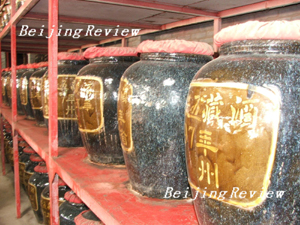
Anyone who has been in China for any length of time will no doubt have experienced the rituals of the banquet. Most notably the endless display of friendship and cordiality shown by caring hosts, whose sole focus it seems is getting as much alcohol down your throat as is humanly possible in the space of 60 minutes.
And on eight out of 10 occasions the preferred tipple is going to be a variety of Daoguang 25, the imperial spirit that has loosened tongues from Harbin to Hong Kong for as long as vat taps have been turning.
I recently was part of a group that had the opportunity to tour the Daoguang distillery, a sprawling factory complex in Jinzhou, China's most northern port in Liaoning Province.
The air around the plant is suffused with the smell of fermenting grain. Over at the demonstration workshop energetic workers show how the Manchu ethnic group made traditional liquor back in the imperial days of the Qing Dynasty (1644-1911). It looked like very hard work--and no doubt can build up quite a thirst.
It's a process that apparently hasn't changed at all in over 200 years and the formula that served the royal family back then is very much a guarded one. What is known is that Daoguang 25 incorporates a mix of red sorghum, pearl barley, millet and tare seeds. Ginseng powder, used as the yeast base, is spiked with a mix of 26 Chinese spices. Lips are sealed as to their identity.
Speaking about "sealed," it is this part of the process that is unique to the Daoguang 25 range of spirits, and gives it its slightly yellow color and hint of sweet sesame flavor.
Traditionally the fermented liquid was placed into large wooden vats, which were then sealed using a mixture of deer's blood, sesame oil and xuanzhi, rice paper good for traditional Chinese painting and calligraphy.
Anyone who doubts the efficacy of this rather gory, gooey sealant, read on. In 1996, when the company was dismantling its old distillery to relocate in Jinzhou City, builders came across four huge wooden vats containing over 4 tons of ancient liquor stored in an underground cave. Experts dated the liquor back to 1845 and proclaimed it fit for consumption, citing the sealing method as the key to longevity. It was named Daoguang 25. Undoubtedly liquor of this vintage soon became a valuable commodity, both in money terms and from a cultural point of view. The state has taken ownership of this unearthed stockpile, and declared it a "drinkable cultural relic."
So valuable are the timeless spirits that the State Administration of Cultural Heritage consented to sell off 93 kg to raise funds for research and protection of the rest of the cache. It went under the hammer in Guangzhou in 2003 for a record breaking 5.58 million yuan (almost $680,000). It is not known who bought the liquor.
Any cultural relic that could disappear in the blink of a toast had better be disposed of very judiciously and I wonder how long one could resist the temptation of dipping into the 4 tons again.
Realizing they were onto a winning wicket, the distillers applied for entry into the Guinness Book of Records. They met with success. The ancient alcoholic drink is now recorded as the "world's oldest cellar-stored white spirit."
Looking at the first wooden vat unearthed, on display in the distillery, it's hard to imagine it could have stored anything for that long. It seems such an interesting spin-off of China's ongoing development that construction and renovation consistently unearth ancient buried treasure of one kind or another. I guess I could even call it a win-win situation, to coin my favorite media phrase.
Leaving the premises our group passed an area fronting the administration offices, outside of which statues of past company officials struggled to be seen through unkempt vegetation and where a variety of caged animals were housed. Next to a cage of yellow monkeys, two spotted deer stood in the sunshine, their wet noses sniffing the wind as we walked past. I glanced at the factory manager, who must have guessed what I was thinking. "These animals are just kept as pets," said the guide quickly.
What an unfortunate choice of animal to keep as a pet in a cage, outside a distillery that boasts about using deer blood in its sealing process.
At that evening's banquet, the Daoguang 25 was raised high in a toast of glory. We toasted the spirit of the past, present and future. I wondered on what occasion the state-owned treasured vats would be dipped into. It would have to be something very special-like toasting China's gold medal count at the 2008 Olympic Games perhaps? Let's wait a few more years and see.
The author is a South African living in Beijing.
| 